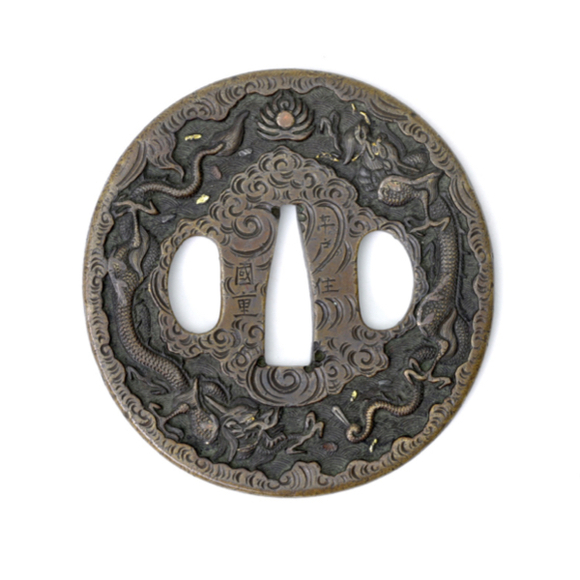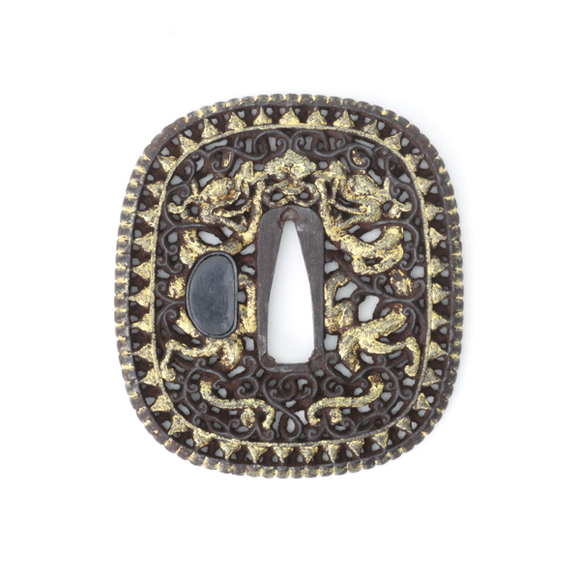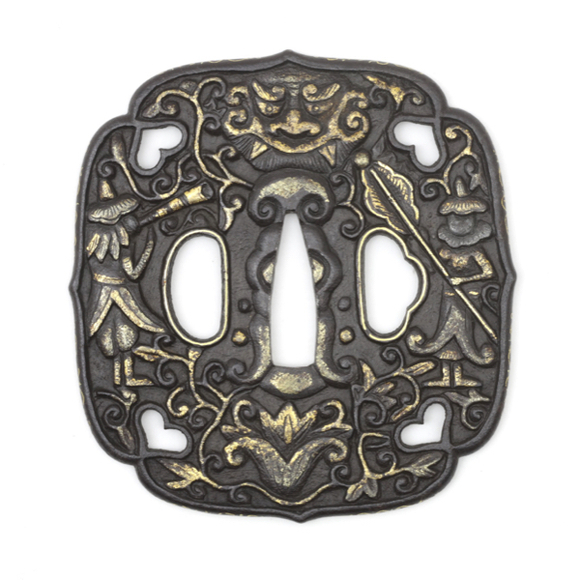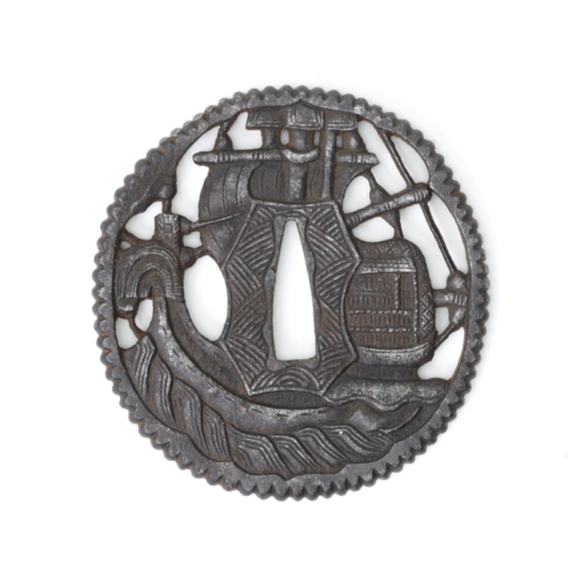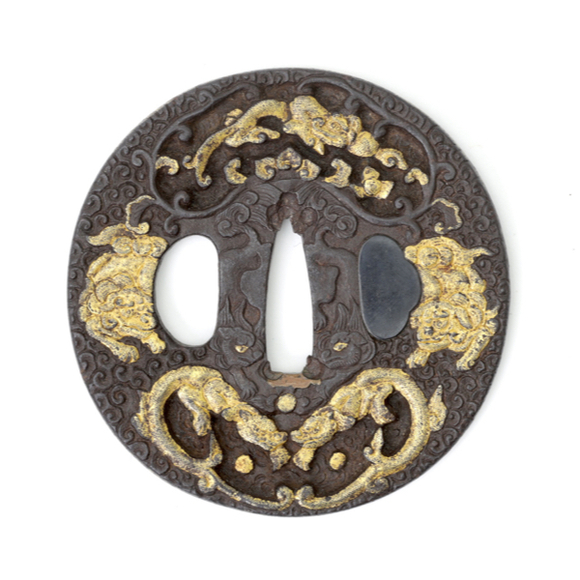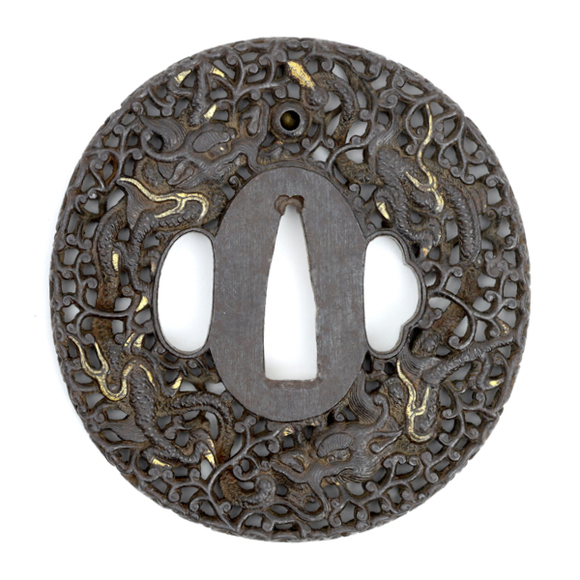Language: Japanese
Source: Antique sword fittings & period literature
Description
Signatures of a certain Hirado Kunishige (平戸國重) appear on a group of mainly copper alloy sword fittings, but in rarer instances, other metals are seen. The work often exhibits fine carving and a mix of Western and Chinese motifs.
 Tsuba signed:
Tsuba signed:
平戸 國重造:
Hirado Kunishige tsukuru
NBTHK Hozon papers.
Author's collection.
Work style
They are usually carved with designs of Chinese-style dragons chasing pearls. They sometimes include the addition of Western or quasi-Western script or other foreign-inspired motifs. Inlay is sometimes added, as is green patination in the recesses. On a very small group we find enamel, like the example below.
Tsuba are most common, but there are also fuchikashira, kōgai and kozuka. All extremely rare.
In the literature
Information about this maker is scarce. The first generation Kunishige is thought to have been active around the Kyōho period, (1726-1736).1
One of the few historical mentions of this maker is in the Sōken Kishō (装剣奇賞) of 1781, Volume 4:
"Kunishige (国重) – Signatures with the reference “Hirado-jūnin” (平戶住人, “resident of Hirado”) exist. It is also said that there exist signatures of the type “Keishi Kunishige” (京師国重, “Kunishige, old capital of Kyōto”), but more details are unknown, and it is possible that these signatures are forgeries.
Worked in brass, copper, shibuichi, and other materials. He was the first to engrave Dutch-style dragons and similar motifs. His works can be regarded first-class." 2
The dragons are, of course, Chinese style, but at the time, Dutch style was used as a blanket term to cover most things foreign.
The reference to Kyoto here is interesting, because a number of exponents of the Ichinomiya Nagatsune school did work that clearly is strongly inspired by Kunishige.3 Similarities even include dots in the O's of the Western script that Kunishige did, so it seems no coincidence.
Notes
1. Fukushi Shigeo; Tosogu Classroom. Volume II. Translation by Markus Sesko. Page 520.
2. Inaba Michitatsu; Sōken Kishō (装剣奇賞) of 1781.
3. See my article Signed Nanban tsuba.
Examples of Kunishige work

Hirado Kunishige tsuba.
Copper alloy, enamel, and gold inlay.
Mandarin Mansion inventory, 2023.

Hirado Kunishige fuchi and kashira.
From the koshirae that came with a Yamato Shikkake katana.
Sold by Mandarin Mansion in 2022.

A tsuba and fuchi kashira by Hirado Kunishige.
Tsuba and fuchi signed:
平戸住國重
Hirado-jū Kunishige
C.R. Boxer collection. Published 1931.

Two menuki , unsigned but thought to have been made by Hirado Kunishige.
C.R. Boxer collection. Published 1931.
Signatures
Signatures encountered are:
Hirado-jū Kunishige (平戸住國重), sometimes with kao (a personal seal)
Hirado Kunishige tsukuru (平戸國重造)
Hirado-jū Kunishige tsukuru (平戸住國重造)
Hirado Kunishige (平戸國重造)
Hirado Kunishige saku (平戸國重作)1
A puzzling element about Hirado Kunishige is that while the pieces are stylistically quite uniform, the style of the signatures really is not. There is also some variation in the quality of execution from quite mediocre to excellent, and some of his best work was rewarded Juyō by the NBTHK. This led me to believe that, at some point, it was probably a workshop or atelier rather than a single maker.
Notes
1. Fukushi Shigeo; Tosogu Classroom. Volume II. Translation by Markus Sesko. Page 520.
Historical context
Hirado island lies west of Kyushu, and was ruled by the Matsura daimyō family for over 800 years. Due to its convenient location, the island long served as a trade hub with mainland China. Even during Japan's period of isolation between 1639 to 1853, lots of trade still went through Hirado, both legally and illegally.
It was at some point home of trade posts of the Portuguese (1550-1565), British (1613-1621), and Dutch (1609-1641), and there was a base of Chinese pirates of the House of Zheng, lead by Zheng Chenggong, a.k.a. Koxinga. He was a powerful pirate lord who ran a maritime empire with bases across Southeast Asia, coastal China, and Japan.
Hirado was also from where Japanese Samurai mercenaries were hired out to colonial and pirate forces. In around 1600, a group of Korean potters settled on Hirado after being taken hostage during the Imjin wars. They produced a specific type of pottery that came to be known as Hirado ware. Perhaps contact with these Korean workers inspired Kunishige to experiment with enamel.
Sword mounts with strong foreign influence often emerged near foreign trade centers. Their market was most likely the (foreign) traders who brought them as gifts on diplomatic and trade missions.

